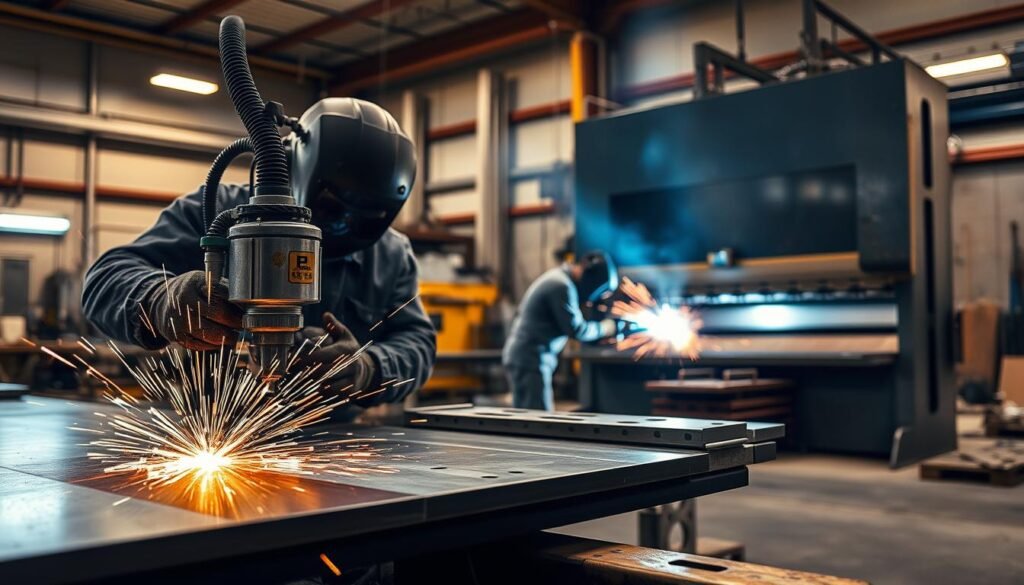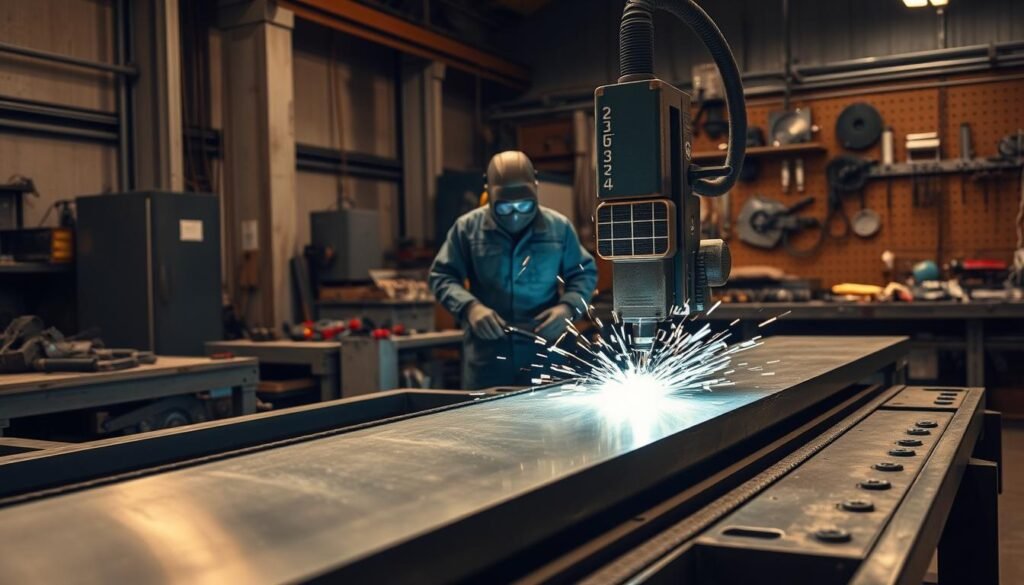Ever wonder about the detailed metal parts in cars, machines, or home gadgets? At Mekalite, we see sheet metal work as a key part of making things. It’s vital for many businesses, giving them top-notch engineering that’s all about quality and trust.
We’ll cover the various methods, important tools, and many uses of sheet metal work. We want to make the complex stuff simple. This way, makers can fully use Mekalite’s precise solutions.
Key Takeaways
- An overview of the significance of sheet metal fabrication in modern manufacturing.
- Insights into the common materials used in sheet metal processing.
- A comprehensive look at various cutting, forming, and joining techniques in sheet metal fabrication.
- The crucial role of CAD models and G-code in the design stage.
- A deep dive into post-processing and finishing methods that enhance the final product.
Let’s dive in and talk about the skill and precision needed for great sheet metal work.
Introduction to Sheet Metal Fabrication
Sheet metal fabrication turns flat metal sheets into custom shapes and sizes. It’s crucial for making many products. It requires skill in different metal fabrication techniques. At Mekalite, we’re experts at this, delivering beyond what’s expected.
What is Sheet Metal Fabrication?
Fabricating sheet metal is complex. It involves cutting, bending, and putting together sheet metal materials. This creates parts or products with exact sizes and shapes. We use modern tools and methods for this, making sure our work is top-notch.
Common Materials Used
Choosing materials is key in sheet metal fabrication. Commonly used sheet metal materials include:
- Steel: It’s strong and flexible, great for many uses.
- Aluminum: It’s light and doesn’t rust, perfect for aerospace and cars.
- Copper: It conducts electricity well, so it’s often used in electronics.
Each material has special qualities for different needs. We offer tailored solutions for various industries.
Industries Utilizing Sheet Metal Fabrication
Many industries rely on sheet metal fabrication:
- Aerospace: Here, precision and dependability are vital. Metal parts are key.
- Medical Devices: High-quality materials and strict standards are needed for safe medical gear.
- Electronics: Custom metal parts protect and make electronic devices work.
We use our know-how and industry insights at Mekalite to achieve great things with metal fabrication techniques.

Design Stage in Sheet Metal Fabrication
The design phase is vital in sheet metal fabrication. It ensures accuracy and efficiency. CAD (Computer-Aided Design) models are used to make detailed digital blueprints. These blueprints guide all the steps that follow.
Importance of CAD Models
CAD design makes very detailed and correct images of the final product. It’s really important to have accurate sheet metal CAD models. They help us see problems before we start to make anything. By using advanced CAD software, we can try out many processes like laser cutting and bending. This ensures our designs meet all the needs and standards. Doing this helps avoid errors and saves money and time.
Generating G-code for CNC Machines
After making the CAD models, we have to turn these designs into G-code. G-code tells CNC machines how to do precise cuts and other tasks. This makes sure that the physical making of the item is very accurate. By creating correct G-code, we make sure the design turns into a real product the right way. This maintains the product’s quality.
Various Sheet Metal Fabrication Processes Explained
Sheet metal fabrication is about shaping, forming, and putting together the final product. At Mekalite, we use a bunch of cool techniques. Let’s talk about cutting, forming, and joining.
Cutting Techniques
Sheet metal cutting needs to be precise and save resources. We use laser, plasma, and waterjet cutting. Laser cutting is super accurate, great for tricky shapes. Plasma cutting works well for thick stuff. Waterjet cutting can handle lots of materials without getting them too hot.

Forming Techniques
Changing the shape of metal without taking any away keeps it strong. We bend, stamp, and draw metal to get the shape we want. Bending squishes metal along a line. Stamping uses a die for shaping. Deep drawing pulls metal into hollow shapes. These metal forming methods are how we make parts just right.
Joining Techniques
We put pieces together with metal joining processes like welding, riveting, and gluing. Welding is for parts that really need to stick together. Riveting holds different materials well. Gluing keeps things tight without heating them up. We pick the best method for each project to make sure it lasts.
| Process | Techniques | Applications |
|---|---|---|
| Cutting | Laser, Plasma, Waterjet | Precision parts, Complex shapes, Thick metals |
| Forming | Bending, Stamping, Deep Drawing | Structural components, Metal casings |
| Joining | Welding, Riveting, Adhesive Bonding | High-stress joints, Mixed materials, Durable assemblies |
Post-Processing and Finishing
After making the product, the steps that come next are very important. They help improve the product’s quality and how it works. Our methods make sure the final product is strong and looks good, just as our clients want.
Heat Treatment
Metal heat treatment is used to make materials better. For example, annealing makes metals less hard and more bendable. This is very important for items that need to be strong and last long.
Surface Finishing Techniques
includes bead blasting, anodizing, and powder coating. These methods are crucial for industries like aerospace and health care. They help make metal products precise and durable. Different finishes also protect against rust and wear.
Powder coating comes in many colors and looks, like shiny or semi-shiny. It can be quite thick for extra protection. Anodizing works with aluminum and titanium, giving different looks and thicknesses. Electroplating uses metals like tin and nickel for a tough, thin layer. This layer helps protect the product.
For more details, see The Ultimate Guide to Sheet Metal Finishing.
- Bead blasting works with many metals, like aluminum and steel.
- Anodizing is good for aluminum and titanium.
- Powder coating offers a range of colors and finishes.
- Electroplating can be done with metals like tin and nickel.
Conclusion
Sheet metal fabrication is key in making many items we use daily and advanced tech parts. We looked at its various steps, from design to cutting and joining. Each step ensures products are well-made and last long.
At Mekalite, we offer comprehensive sheet metal services for our clients. Our industry-leading metal fabrication uses top tech and precision. We keep leading the way in making sure our work is the best, giving great value.
As manufacturing changes, we keep aiming for the best. With Mekalite manufacturing solutions, clients get unmatched quality. We’re excited to work with you on turning great ideas into real items with our expert sheet metal work.
FAQ
What is sheet metal fabrication?
A: Sheet metal fabrication shapes flat metal sheets into different forms. At Mekalite, we cut, form, and join metal. This makes precise parts for many industries.
What materials are commonly used in sheet metal fabrication?
Mekalite often works with steel, aluminum, and copper. These materials suit needs in aerospace, medical devices, and electronics. Each has special properties for different uses.
Which industries utilize sheet metal fabrication?
Many industries need sheet metal fabrication. Mekalite serves aerospace, medical devices, electronics, automotive, and consumer products. We focus on precision and quality.
Why are CAD models important in the design stage of sheet metal fabrication?
CAD models give us a precise digital plan of the part needed. They help make production accurate and efficient. This ensures the final product meets high standards.
How is G-code generated for CNC machines in the fabrication process?
G-code controls CNC machines. We turn CAD models into G-code. This tells CNC machines how to cut and engrave accurately. It ensures parts are made right.
What are the primary cutting techniques used in sheet metal fabrication?
We use laser, plasma, and waterjet cutting. These methods cut precisely and save materials. This is key to making high-quality parts with less waste.
What forming techniques are used in sheet metal fabrication?
Bending and stamping reshape metal without removing any. These techniques keep the metal strong. They are crucial for the parts we make at Mekalite.
What joining techniques are applied in sheet metal fabrication?
Mekalite uses welding and riveting to put together complicated parts. We choose methods that meet manufacturing needs. This makes assemblies strong and reliable.
How does post-processing enhance sheet metal products?
Post-processing strengthens the metal. Treatments like annealing make it durable. Finishing with powder coating or anodizing makes it look good and last longer. We are committed to quality.
What are the surface finishing techniques used in sheet metal fabrication?
We use powder coating and anodizing at Mekalite. These improve looks and protect against damage. They help our products last longer and resist corrosion and wear.




